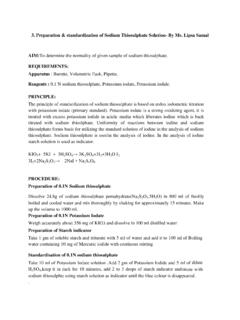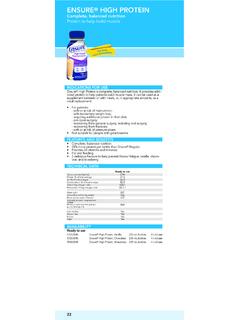Transcription of TITRIMETRIC ANALYSIS - NCERT
1 UNIT-6 TITRIMETRIC ANALYSISYOU are already aware that a substance is analysed to establish its qualitativeand quantitative chemical composition. Thus, chemical ANALYSIS can becategorised as qualitative ANALYSIS and quantitative ANALYSIS . In this unityou will learn about determination of the amount of substance in solution. Dependingupon the method adopted for determining the amount of chemical substances insolution, there are two methods of ANALYSIS namely, TITRIMETRIC ANALYSIS andgravimetric ANALYSIS . In TITRIMETRIC ANALYSIS measurement of only volumes is involvedwhile in gravimetric ANALYSIS measurement of volumes as well as mass is ANALYSIS involves determination of the volume of a solution ofaccurately known concentration, which is required to react quantitatively withthe measured volume of the solution of a substance, concentration of which is tobe determined.
2 The solution of accurately known concentration is called standardsolution. The mass of the substance dissolved in the solution of unknownconcentration is calculated from the volume of the standard solution used, thechemical equation and the relative molecular masses of the reacting reagent of known concentration is called titrant and the substance beingtitrated is termed as carry out TITRIMETRIC ANALYSIS , standard solution is usually added fromthe long graduated tube called burette. The process of adding the standardsolution to the solution of unknown concentration until the reaction is justcomplete is called titration. The point at which reaction is completed is calledequivalence point or the theoretical or stoichiometric end point. It is notpossible all the time to take standard solution in the burette.
3 You will come to knowabout it later in this unit in the titration of sodium hydroxide with oxalic DETECTION OF END POINTThe end point is detected either by some physical change produced in the reactionmixture itself or by the addition of an auxiliary reagent, known as indicator;alternatively some other physical measurement may be used. At the completionof the reaction, the indicator shows a visible change (colour change or turbidity)in the solution being titrated. In an ideal titration, the visible end point coincideswith the stoichiometric or theoretical end point; but in practice usually somesmall difference occurs. This represents titration and the experimental conditions selected should be such that thedifference between the visible end point and the theoretical end point for a Reaction in the TITRIMETRIC Analysis66 LABORATORY MANUAL REQUIREMENT FOR A REACTION IN THE TITRIMETRIC ANALYSIS (i)The substance of which amount is to be determined bytitrimetric ANALYSIS must react completely and rapidly withthe other reagent in stoichiometric proportion.
4 (ii)The reaction should be fast and there must be alteration inphysical or chemical property of the solution at theequivalence point, which can be detected by an indicator, orby measuring the potential difference or current ACIDIMETRY AND ALKALIMETRYT itrimetric ANALYSIS can be carried out for various types of this unit you will learn only about neutralisation involve titrations of acids and bases. Standard solutions ofacids (acidimetry) and bases (alkalimetry) are used in thesetitrations. In quantitative estimation through TITRIMETRIC ANALYSIS ,concentration of solution is expressed in terms of molarity. It isnumber of moles of solute dissolved in 1 litre of , M = number of moles of solutevolume of solution in litresStandard SolutionA solution of exactly known concentration is called standardsolution.
5 Any substance, which is stable at room temperature anddoes not react with solvent in which it is dissolved, can be directlyweighed to prepare its standard solution. Description andpreparation of these solutions is given below:Primary and secondary standardsA primary standard is a compound of sufficient purity in whichtotal amount of impurities does not exceed Thestandard solution can be prepared by direct weighing of a sampleof primary standard followed by its dissolution in water (or solvent)to obtain a definite volume of solution. The substance to be used asa primary standard should also satisfy the following requirements:1. It must be easily available in pure and dry It should not undergo change in air it should not behygroscopic, oxidised by air or affected by gases such ascarbon dioxide present in the atmosphere or lose water ofcrystallization, so that it can be stored It should be easy to detect the impurities present in It should have high relative molecular mass so that weighingerrors are Its reaction with another substance should be instantaneousand The substance should be readily soluble in ANALYSIS67It is difficult to obtain an ideal primary , substances having characteristics nearer to theprimary standards are usually hydrated salts, as a rule, should not to be used asprimary standards.
6 However, sodium carbonate, sodiumtetraborate, potassium hydrogenphthalate, oxalic acid, ferrousammonium sulphate etc. can be used as primary standardsbecause of their sufficient solution of secondary standard is the one which may beused for standardization after finding out its exact concentrationby titration against a standard solution of primary secondary standard cannot be used for preparing standardsolution by direct weighing. sodium hydroxide and potassiumpermanganate are examples of secondary starting TITRIMETRIC ANALYSIS , you should be familiar withsome techniques such as, weighing by using chemical balance,preparing standard solution, measuring volume by using buretteand INDICATORS IN ACID BASE TITRATIONAcid base indicators are sensitive to pH change. For most acid basetitrations, it is possible to select indicators which exhibit colourchange at pH close to the equivalence point.
7 We will discuss hereabout only two indicators phenolphthalein and methyl is a weak acid, therefore it does not dissociate inthe acidic medium and remains in the unionised form, which H+ + Ph UnionisedIonisedColourless PinkIonised and unionised forms of phenolphthalein are given below :(Colourless in acid)(Pink in alkali)Fig. : Phenolphthalein in acidic and basic medium68 LABORATORY MANUAL CHEMISTRYIn the acidic medium, equilibrium lies to the left. In the alkalinemedium, the ionisation of phenolphthalein increases considerablydue to the constant removal of H+ ions released from HPh by theOH ions from the alkali. So the concentration of Ph ion increasesin the solution, which imparts pink colour to the H+ + Ph NaOH Na+ + OH H+ + OH H2 OFor a weak acid vs strong alkali titration, phenolphthalein isthe most suitable indicator.
8 This is so because the last drop ofadded alkali brings the pH of the solution in the range in whichphenolphthalein shows sharp colour orangeMethyl orange is a weak base and is yellow in colour in the unionisedform. sodium salt of methyl orange is represented as follows:Benzenoid form of the anion(Yellow in colour)Quinonoid form of the anion(Pinkish red in colour)(Bronsted-Lowry base)Fig. : Structures of Methyl orangeChoice of IndicatorIn the titration of strong acid and a weak base, methyl orange ischosen as indicator. When titration between strong base and weakacid is to be performed then phenolphthalein is a good this case alkali is dropped from the burette and acid is taken inthe tiration flask. Colour of the solution taken in the titration flaskThe anion formed from the indicator is an active species, whichon accepting a proton ( acting as Bronsted Lowry base) changesfrom the benzenoid form to the quinonoid form.
9 The quinonoidform is deeper in colour and thus is responsible for the colourchange at the end point. This is illustrated in the following manner: TITRIMETRIC ANALYSIS69changes from colourless to pink. This change of colour is easilyperceptible to the human eye. If we take alkali in the titration flask,the colour change will be from pink to colourless and accuracy innoting the colour change may be less. In the titration of strongacid versus strong base anyone of the above indicators can beused. For the titration of weak acid vs weak base no indicator of the concentration (strength) of a given sodiumhydroxide solution by titrating it against a standard solution ofoxalic the titration of a strong acid with a strong base, the amount ofacid and base becomes chemically equivalent at the end point andthe chemical reaction is called neutralization reaction.
10 Near theend point there is a sudden change in the pH of the solution. Ifafter end point even a small amount of base/acid is added thesolution would become slightly alkaline or acidic respectively. Inthe titration between oxalic acid (weak acid) and sodium hydroxide(strong base), following reaction takes place:In this titration phenolphthalein (HPh) is used as an concentration of unknown solution is calculated in of the solution can be calculated by using the formulaa1 M1 V1 = a2 M2 (4)where a1, M1, V1 are respectively basicity, molarity and volumeof acid used and a2, M2 and V2 are acidity, molarity and volumerespectively of base used in the MANUAL CHEMISTRY Oxalic acid: As per need sodium hydroxidesolution: As per need Phenolphthaleinindicator: As per needMaterial Required Burette (50 mL):One Pipette (10 mL):One Conical flask (100 mL):One Burette stand:One Funnel:One White glazed tile:One Measuring flask (100 mL).














